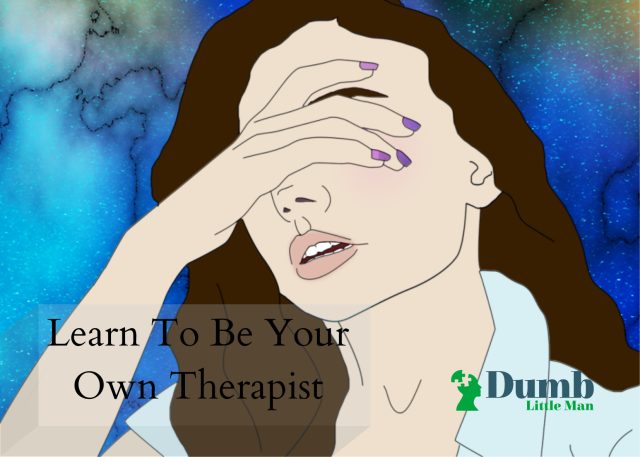Learn To Be Your Own Therapist

Let’s get one thing straight, at the end of the day, it isn't your mentor/ coach/ therapist/ counselor who does the transformation work for you. It is You who does it. Yes, of course, others can support, guide, teach, hold space, but you are the one who has to do the work. It’s like a gym – the gym instructor can point you to the right machines, but can’t get on to them to build your muscles for you!
Now, don’t get me wrong with the title – I’m not saying Therapists are useless. But I AM saying that you don’t need a therapist, especially long-term. Let’s break this down.
Question: Who needs healing?
Answer: Everyone.
Question: How can everyone need healing?
Answer: Because we live in a fractured world, that’s constantly traumatized.
Question: What do you mean?
Answer: I mean, look around you! Never before has it been so easy to connect with humans across the world. While that has its pros, there are also cons. The way that life is, there are always ups & downs. And this across-the-world connection ensures we absorb all the many downs too. Thus, every moment, whether or not in my immediate circle, I’m suffering the collective trauma.
Question: So, where does that leave me?
Answer: That leaves you, my friend, is a very understandably difficult situation where stress & anxiety are part & parcel of life.
Question: Where do we go from here?
Answer: It’s not the stressors that are the issue. Plus, of course, it’s difficult to really control the stressors. Most of us have tried it – doesn’t really work, does it?! The work that’s needed is to build the capacity within to work with these stressors in a way that they don’t stress you out.
Question: How do I do that?
Answer: Well, one short answer that everyone seems to be jumping to these days is, “Get a therapist!”
Therapy
Here’s the deal about therapy/ counseling – most of it is pretty damn expensive! In countries like India, the ones who go really deep into body, emotions, trauma work, are quite out-of-budget for most people. In a country like the USA where there’s insurance that makes it cheaper, the wait to get a therapist is insane! And there’s no guarantee that the therapist you get after all the hassle will be the best fit for you. So what do you do in the meantime?
The PILR Process
I’ve been in the space of people development for more than a decade now. Having traversed the roles of a teacher, coach, therapy practitioner, yoga instructor, meditation guide, here’s what I’ve gathered: Each person has the capacity to heal their past wounds & traumas. All that is needed is for you to reconnect with the self-healing capacity that has always been there within each one of us.
Question: How do you reconnect?
Answer: Use PILR – Pause, Invite, Listen, Release
You can use this process to work through your anxiety, stress, and fears. You can also use it to build your emotional tolerance muscle, awareness, and clarity.
Pause

Pause whatever you’re doing. Breathe. Take a slow, gentle, deep breath in, and then slowly let it fully out through the mouth. Repeat this in & out-breath cycle, notice your body slowing down. Observe this shift from the fast pace to slowness. No matter how small the shift – notice the shift. As you notice the shift, you’ll find that the slowness expands, and you’ll find yourself beginning to calm down.
Invite
Once you’re relatively calm, invite in whatever unnerved you – the doubt, the fear, the anxiety, the overwhelm – whatever it was, invite it in. You’ll notice when you invite it in, it stops being scary. The way to invite it is to allow yourself to see it – what color is it, what shape, how it smells, how it feels. As you begin seeing it in its details, you’ll notice how it’s separate from you, and maybe it’s here for some reason.
Listen

Now is the time to deeply listen to what it’s here for. Be curious to know its back story. Where is it coming from? When was it born? How did it help you in the past? What is it here to tell you now? Ask it these questions from a space of genuine curiosity, really opening yourself up to listen in.
Release
Once you fully listen to its concerns, once you acknowledge its presence & its good intent – thank it. Let it know you’ve got its message, & you’ll keep the message in mind while making a sound stable decision from your grounded self. Once seen, acknowledged, & heard, it’s ready to leave – aid its release by doing some gentle stretches, like, opening up your chest, stretching out your arms wide above your head. Shaking helps too – shake your hands, shake your feet,
stand up & shake your whole body. And then close the loop with the in & out-breath cycle we learned in the Pause stage.
As you begin practicing PILR, you’ll start to notice shifts in your anxiety & stress levels. You’ll also begin connecting with this stable, grounded, wise part of you, that’s always been there in you.
It is never the circumstance that’s the suffering. Circumstances can cause pain, but suffering is caused by the way we interact with the painful circumstance.
The Story of The Second Arrow
It is said the Buddha once asked a student, “If a person is struck by an arrow, is it painful?”
The student replied, “It is.”
The Buddha then asked, “If the person is struck by a second arrow, is it even more painful?”
The student replied again, “It is.”
The Buddha then went on to explain, “In life, we can’t always control the first arrow. However, the second arrow is our reaction to the first. This second arrow is optional.”
Shobhali Thapa
I practice as an Inner Work Guide, living at the nexus of coaching, therapy, and spirituality. I work with women who feel intensely, are passionate, & believe that there's something more to life - enabling them to heal & transform all aspects of their lives, & to create powerful healing spaces for those around them.


